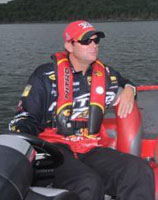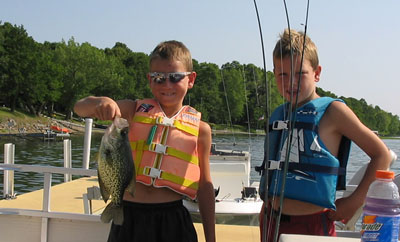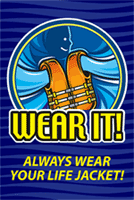Are you Safety Conscious on or near the Water?
by: Tom Branch, Jr.
During
the summer months most people like to fish, boat and swim; which means
you are on or near the water. Just because people can swim does not
mean  that they are. It is also the time of the year when more people
drown. All drowning are preventable (period). When you are in a boat
or near the water always wear your life jacket; sitting on a life jacket
is like not wearing one.
that they are. It is also the time of the year when more people
drown. All drowning are preventable (period). When you are in a boat
or near the water always wear your life jacket; sitting on a life jacket
is like not wearing one.
According
to the National Safety Council, Inc., almost 7,000 people drown in
the United States each year. Drowning is the second-leading cause in
accidental death in children. Almost 1,200 children are killed each
year and even more are injured in near-drowning incidents. In 2010,
Gwinnett County, Georgia firefighters responded to 39 drowning or near
drowning incidents. So far in 2011 Gwinnett County firefighters have
responded to 29 drowning or near-drowning incidents in just the first
6 months of this year. For every child who drowns, four others are
hospitalized for near-drowning, and as many as three suffer brain damage. Most
drowning usually occurs quickly and silently. Childhood drowning and
near-drowning can happen in a matter of seconds and typically occur when
a child is left unattended or during a brief lapse in supervision. Two
minutes following submersion, a child will lose consciousness. Irreversible
brain damage occurs after four to six minutes and determines the immediate
and long-term survival of a child. Not all of these incidents involved
children, swimming pools, rivers and lakes. We all should know not to
swim alone. Using the buddy system means there's always someone looking
out for you.
Lakes/Ponds/Rivers and Steams
The lakes, rivers, and streams are very tempting to swim in at this time
of the year because of the unusually hot temperatures. Swimming,
boating and other water sports always require the participants to be
extra careful, but this year the threats to  personal safety are even
greater and are on my mind. The Chattahoochee River always
seems to be flowing higher and fast every year. Presently, the river
has horn/siren to warn people downstream of the rising water. When
near the river it is a requirement that a life jacket be worn 100%
of the time, no exceptions. The horn sounds and you need to leave the
area immediately (period). There are always trees, brush, garbage and
other hazards in the rivers as well, so until the flow rate is slow,
it is best to stay out of the water. Wearing proper fitting life jackets
in around lake, ponds, rivers and streams is a must. Currently the
lake water in our area is filled to capacity and more people are out
and around the lakes. Remember after any heavy rains there will be
floating debris in the lake that could creates hazards for boaters,
but it is also possible for swimmers to get hung up on submerged trees,
logs or limbs.
personal safety are even
greater and are on my mind. The Chattahoochee River always
seems to be flowing higher and fast every year. Presently, the river
has horn/siren to warn people downstream of the rising water. When
near the river it is a requirement that a life jacket be worn 100%
of the time, no exceptions. The horn sounds and you need to leave the
area immediately (period). There are always trees, brush, garbage and
other hazards in the rivers as well, so until the flow rate is slow,
it is best to stay out of the water. Wearing proper fitting life jackets
in around lake, ponds, rivers and streams is a must. Currently the
lake water in our area is filled to capacity and more people are out
and around the lakes. Remember after any heavy rains there will be
floating debris in the lake that could creates hazards for boaters,
but it is also possible for swimmers to get hung up on submerged trees,
logs or limbs.
Do you know how to check to ensure you or your children are wearing
a proper fitting life jacket? All life jackets come with a standard label
with the proper weight range to match you and your child's weight. If
you are not sure if they are fit properly spend a few minutes and visit
your local Bass Pro Shops or a Water Sports store for instructions
on the proper fitting of a life jacket.
Swimming Pools
It's important to teach your kids proper pool behavior and to make
sure that you take the right precautions. Children shouldn't run or
push around the pool and they should never dive in areas that are not
marked for diving. If the weather turns bad (especially if there's
lightning), everyone should get out of the pool immediately and seek
cover. Above all, we all must supervise our children 100% of the time.
Don't assume that just because your child took swimming lessons or
is using a flotation device such as an inner tube or inflatable raft
that there is no drowning risk. If you're at a party, it's especially
easy to become distracted, so designate an adult who will be responsible
for watching the children in the pool.
Parents should know where their children are at all times, especially
when near or in any body of water, whether large or small. If you own
a pool and a child is missing, remember to check the pool first and then
move on to other areas. Learn CPR and make sure you have safety
equipment close by the pool. There should be an emergency flotation device
close at hand when at a swimming pool. After all the children are finished
playing in the pool, be sure to remove all the pool toys and put them
away. Children have drowned while trying to retrieve toys left in a pool.
Water Parks
The water park industry has produced an excellent track record of delivering
safe family recreation. In fact, a visit to a water park is the safest
way for families to play together in the water. Achieving these results
is not as effortless as floating down a lazy river attraction, however – it
takes a great amount of dedication and teamwork each day at water attractions.
Our local water parks make safety the top priority in staff training,
and today’s professional lifeguards are trained to deliver an
increasingly high standard of care. Only after lifeguards earn the
required authorization through this training process are they then
permitted to staff any of the water parks attractions. Please remember
that the greatest causes of injury at most water parks are the waterslide.
It’s easy to slip and fall on a wet surface; so be careful, safe
and enjoy the park.
At the Beach
A beach vacation is fun for the whole family. Sun, sand, shore and water
offer something for everyone. But for all of the wonderful, healthy
activities time spent by the seaside offers, caution needs to be taken.
Statistics indicate that it is safer to swim on beaches with lifeguard
services present. Lifeguards are trained not only in injury prevention,
but also in emergency response. Should anything go wrong at the beach,
a lifeguard can help make the difference between life and death. Areas
without lifeguard protection may also be areas that have hidden dangers
such as sudden drop-offs, currents and weeds all which can endanger
your safety. From rip currents, to baking sunshine, to getting stung
by a jellyfish the beach can be a pretty scary place but, you can make
it an enjoyable by being educated. While in the ocean, swimmers should
always pick a permanent landmark on the beach. A house, a lifeguard
stand or a hamburger shack is a good target because those things don’t
move. While in the water, the swimmers should make an effort to stay
in front of this landmark. Having a landmark will help children keep
their bearings while they are in the ocean, where strong currents can
pull them in one direction or another without them noticing. If you
do get in a rip current the best thing to remember is to swim to the
side one way or the other until you no longer have difficulties or
feel yourself being pulled. Another option is to tread water until
someone can assist you.
Alcohol and water sports are never a safe mix, yet I know that this
common sense rule is almost never followed. Alcohol impairs peoples'
thinking and physical skills, and since water requires more than just
routine attention, it should be left out when anyone is swimming, boating,
or participating in any other water related activities.
Learn to Swim
The best thing anyone can do to stay safe in and around the water is
to learn to swim. This includes both adults and children.
Some
Advice for All Ages:
 1.
If you don’t know how to swim, take lessons. And remember, if
you do not swim well, stay where you can touch the bottom and wear a
life jacket.
1.
If you don’t know how to swim, take lessons. And remember, if
you do not swim well, stay where you can touch the bottom and wear a
life jacket.
2. Never force a child, or anyone for that matter, to learn to swim if
he or she is afraid of the water.
3. Learning how to float is a good and safe practice to remember.
4. Only swim in areas where there is a lifeguard and remember to always
swim with a buddy.
5. Children should never swim without a parent or guardian present.
At large public pools and beaches, children should always swim in an
area supervised by a lifeguard.
6. Always obey the lifeguard and posted pool rules. No horseplay or showing
off in or around the water.
7. If you hear thunder or see lightning, leave the water immediately.
Remember never to swim at night.
8. Always swim in areas that are safe.
9. Avoid chewing gum or eating while swimming. It could cause you to
choke while in the water.
10. Learn basic First Aid and CPR in order to help others in need.
11. Always wear a life jacket in and around the water.
To get more tips on water safety:
Safe Kids USA site http://www.safekids.org/safety-basics/safety-resources-by-risk-area/drowning/
Red Cross web site at http://www.redcross.org/
About the author: Tom
Branch, Jr. is a freelance outdoor writer and a full time Lieutenant/Firefighter-Paramedic
with over 25 years of service with the Gwinnett County Fire Service
in Georgia. He has been working in the Outdoor Industry for over 15
years and has done everything from successfully managing and developing
a pro fishing team, developing new products, designing packaging, participated
in different radio and television shows and developing Writer’s
Conferences. He and his wife Kim live north of Atlanta in Braselton,
GA with their 2 labs Jake and Scout.
Check out his blog at – http://outonalimbwithtombranchjr.blogspot.com
Follow him on www.facebook.com/tombranchjr and http://twitter.com/tombranchjr

